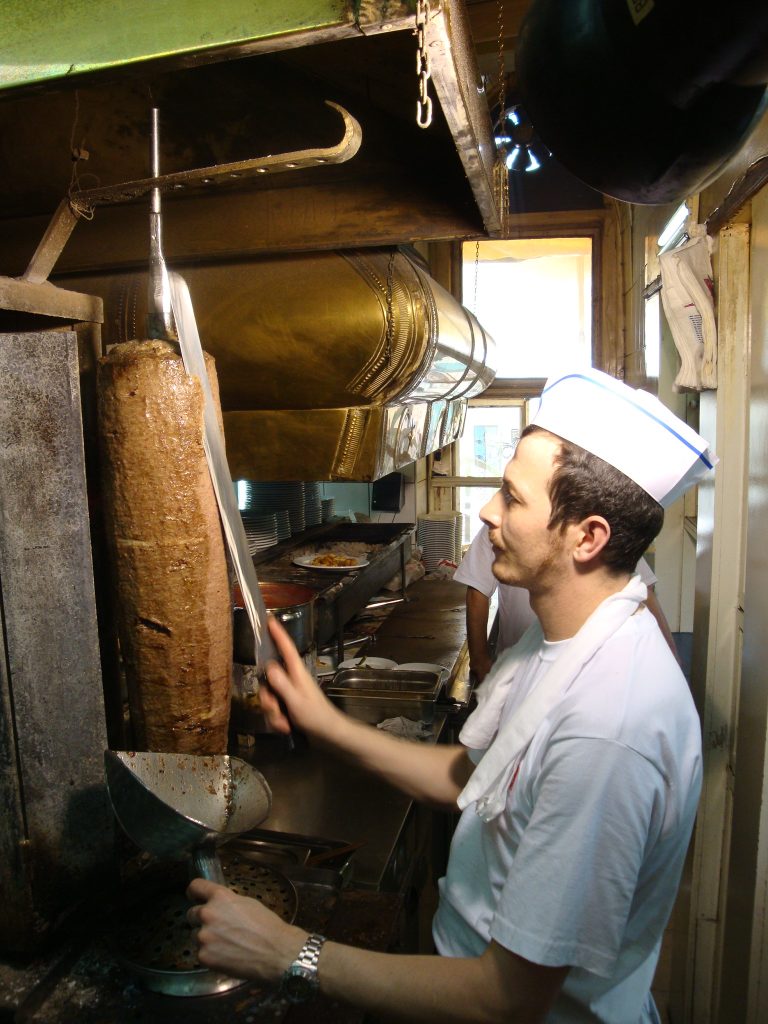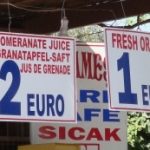
Far and away the most popular item on most Turkish menus is the kebab, a general term for any piece of meat that has been grilled or baked. the different cooking methods justifying the different names given to individual kebabs.
On the whole the cooking tends to be simple even in the smartest restaurants. Often kebabs are simply char-grilled and served with a helping of rice, a green pepper and a salad of tomato, cucumber and lettuce. Although the Adana kebab is notoriously fiery most other kebabs are cooked without much in the way of condiments.
The most familiar kebabs are cooked and served on a şiş (pronounced “shish”, meaning skewer). The standard kebab consisting of cubes of lamb grilled on a skewer is simply called a şiş kebab.
If you can’t decide which kebab to choose many restaurants serve a karışık kebab or mixed grill, an excellent way to get your tastebuds around the problem, especially if you’re dining with friends. Alongside the kebabs a mixed grill is likely to include pirzola (lamb chops) and külbastı (grilled lamb cutlets).
The standard restaurants that specialise in kebabs sometimes call themselves a kebapçı or an et lokantası (meat restaurant). Overwhelmingly the meat on offer will be lamb or mutton with only the very occasional piece of beef. At an ocakbaşı you sit around a central cooking pit and watch as your meat is prepared.
All the meat sold in Turkish restaurants should have been killed according to Islamic halal rules. These dictate that the animal’s throat must be cut and the blood drained out of it which partly explains why most Turks will only eat meat that is well done. Most of the meat served in İstanbul is of the highest quality – you’ll rarely have to chomp your way through a tough old piece of mutton (although toothpicks (kürdan) are usually provided).
- Adana kebab. An Adana kebab is made by moulding minced lamb around a long, flat skewer and seasoning it with paprika and onion. It may have started life in Adana on the south coast but it’s now a mainstay of menus countryside.
- Beyti kebab. To make this kebab, the familiar cubes of lamb shish are wrapped inside yufka (thin bread) which is then sliced up and arranged as meat parcels interspersed with salad around the plate.
- Büryan kebab. The less familiar büryan kebab is semi-baked in a pit oven, then finished off in a more conventional one. The delicious melt-in-the-mouth end product is a favourite of the south-eastern Siirt area of Turkey. Kuyu kebab (pit-roasted kebab) is much the same thing but with a Western Turkish rather than Eastern Turkish heritage. Ditto tandır kebabı.
- Cağ kebab. A favourite of Erzurum, the cağ kebab consists of pieces of lamb marinated in onions and spices and cooked on a horizontal spit. It’s then served like a döner kebab – ekmek arası (in a sandwich), dürüm (in a wrap) or on a plate.
- Çömlek kebab. Cubes of lamb are cooked in an earthenware pot (çömlek). Testi kebab (pot kebab) is the same idea, more usually served in tourist restaurants with flames shooting out of it and much pantomime over breaking the pot open. Watch out for shards of pottery in the sauce.
- Çöp şiş. In a variation on the standard şiş kebap, tiny pieces of lamb are grilled on a skewer.
- Kağıt kebab. Small pieces of lamb are baked inside an outer wrapping of paper that should be removed before eating.
- Manisa (Bohça) kebab. More like long meatballs than a conventional kebab, the Manisa kebab comes served on a bed of pide with a tomato salad.
- Sırık kebab. Speciality of Boyabat area. Grilled lamb shank made from meat of Karayaka sheep, a breed unique to Turkey.
- Talas kebab. The Turkish take on beef Wellington, the Talas kebab consists of pieces of meat fried with onion and then cooked in tomato sauce and parcelled up in puff pastry.
- Tas kebab. Pieces of lamb are sauteed in butter and onion, then cooked with tomatoes.
- Tokat kebab. The delectable Tokat kebab is made by chopping lamb into cubes, then interspersing it with chunks of potato, and aubergine, and a lump of fat, and hanging it up on skewers inside the oven. As the fat melts, so it soaks into the meat and softens it. Just before the meal is ready tomatoes are also hung up to roast. Then the skewers are placed onto plump pieces of pide bread and garnished with a salad. Absolutely unforgettable although not very easy to find.
Written: 5 November 2012


